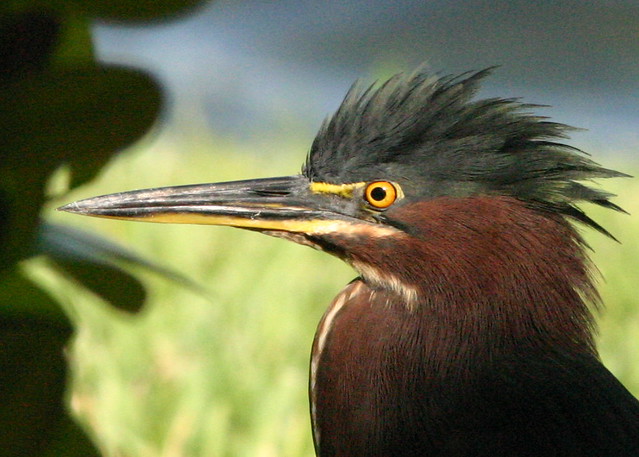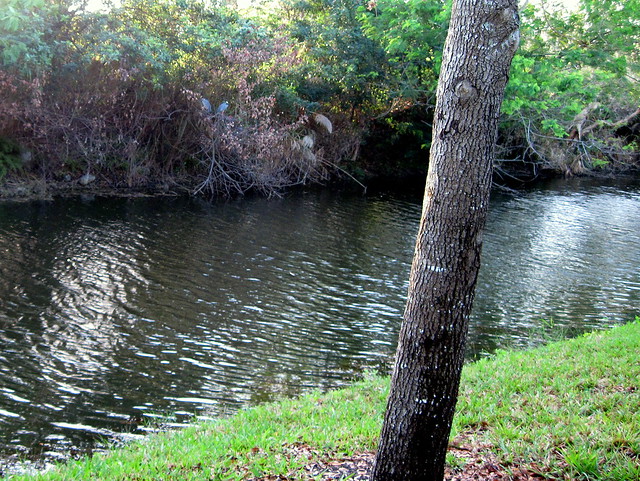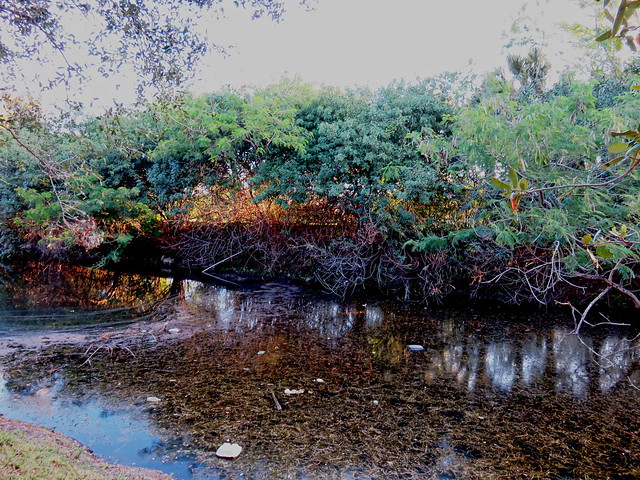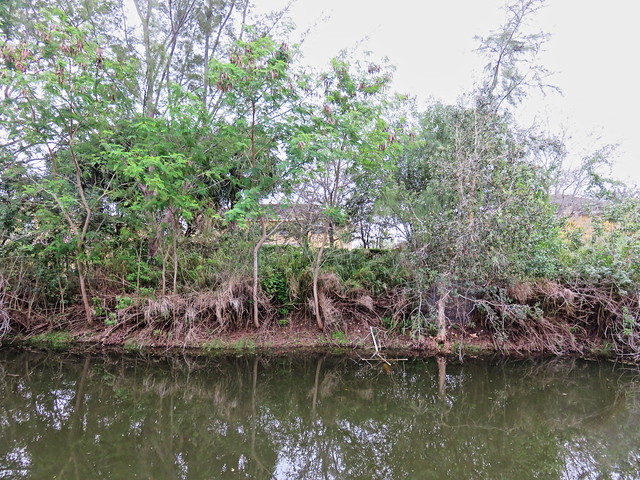


The first herbicide treatment occurred some time before the 2012 breeding season. This photo, taken on March 4, 2012 shows Yellow-crowned Night-Herons on nests exposed by the defoliation:

During the following year the shrubs, mostly Ligustrum and exotic Brazilian Pepper, had recovered somewhat The rookery, which I have been monitoring since the spring of 2011, contained at least 8 nests of Yellow-crowned Night-Herons and 3 Green Heron nests, mostly over the water and still fairly well-concealed, when this photo was taken on March 15, 2013:

This photo, on December 14, 2014, shows the devastating effects of a subsequent herbicide application, along with floating debris from nearby road construction:

Most of the branches which extended over the water were defoliated and killed, as shown in this photo taken on January 15, 2015. Homes that were formerly hidden by the nest trees are now in plain view.

During the spring of 2012, in the Yellow-crowned Night-Heron rookery along a canal at the north end of the wetlands birding patch next to our south Florida home, a pair of Green Herons selected a secluded spot for their nest.
Unfortunately, this tree, which extends over the water, had been treated with herbicides by the agency that maintains the canals, and by the time the eggs hatched almost all the leaves had fallen off to expose the nest.
These brief clips illustrate some interesting behaviors and are best viewed in HD, full screen size. Pardon the shakiness, as they are taken with my hand-held DSLR camera with a telescopic lens, from about 50 feet (15 meters) across the canal from the nest.
The Green Herons are excellent parents. Here a female feeds her tiny chicks, about 3-5 days old. At the time, we only counted three, as the youngest one was not yet visible (April 15, 2012).
Trouble viewing this video? Try visiting https://vimeo.com/40415469
The four chicks have grown quite a bit over the next 3 days. They are now 7-9 days old. Perhaps not unexpectedly in view of the flimsy perches, the smallest chick disappeared the next day, following a heavy thunderstorm (April 19, 2012).
Trouble viewing this video? Try visiting https://vimeo.com/40865604
Now on April 22, the chicks are 10-12 days old. This remarkable sequence shows the protective behavior of the male, who had fed the chicks just moments before I started this video. The female then flew in with more food, but the ravenous appetite of the chicks placed them in danger. The male, sensing their predicament, flew in to solve the problem. See how he did it.
Trouble viewing this video? Try visiting https://vimeo.com/44908718
The Green Heron can be described as a compact little neck-less ball of feathers...
...or a spindle-shaped pointed object:
But where did that neck come from?
Sometimes it looks like almost any other heron, though its legs are short and its neck is a bit thick:
Then, extending its neck full length, it becomes almost snake-like...
...and raises a handsome crest:
Their color-- How did they ever get the name of "Green?" Sometimes they look as dark as crows:
The immature birds have streaked underparts and can be quite dark in color:
Here is an adult. Why, I do see a bit of green in there!
Usually a loner, it is unusual to see several in a flock. These are immature birds. perhaps some are siblings:
Those wings-- they are surprisingly long and seem to have so many more feathers than expected:
During breeding season, the male does have respectable plumes:

Well, they are absolutely incredible pictures of the green Heron! But sorry about the destruction of the habitat.
ReplyDeletesuch beautiful yet quirky birds. love them! gorgeous shots! sorry about their nesting habitat being destroyed!
ReplyDelete(i hope you don't mind - i 'stole' the close-up shot of the heron's head to put in my drawing inspiration folder. i marked it with your name so if i ever draw from it, i'll point folks back here!)
Awesome post on the Green Heron.. It has always been one of my favorite herons.. Great photos and videos.. Happy weekend!
ReplyDeleteThis post brought tears to my eyes! I get so angry about the senseless use of herbicides and pesticides that endanger our wildlife (and US) so much! These are beautiful birds! I loved your photos and your videos, and am just sick there won't be any nestling this year. Too too sad!
ReplyDeleteIt's a very handsome bird. Your photos are awesome.
ReplyDeleteWell done!!! Well done. I had read last week sometime that ABA had chosen the Green Heron. One of my favorites.
ReplyDeleteYour narration here this week is phenomenal. Sad to read about the devastation tho. Hopefully in time it will return to normal. Loved watching the 'care taking' and raising of the chicks in the nest.
Thanks for sharing your post today with us avid birders at I'd Rather B Birdin'!!!
It took me forever to realize that this wasn't two different birds. You were one of my virtual guides, even before this post and I'm grateful . So terribly sorry about the herbicide devastation. When will they ever learn?
ReplyDeleteBeautiful birds! Your photos are wonderful!
ReplyDeleteSo sad that they are losing their habitat
Lea
Theses images are outstanding and I love the videos of the parents feeding the chicks. The last clip is amazing.
ReplyDeleteand, the colours! the colours are amazing........ I hope some of them do alright in spite of humans....
ReplyDeleteSuch great movies of the young nestlings, they really seem to be bottomless pits, it must be hard for the parents to keep up with them. They climb the branch amazingly well! I hope they get some protection from the pesticides.
ReplyDeleteStunning, wonderful image captures, congratulations for so many perfect shares!
ReplyDeleteSuch interesting birds. Your photos and videos are spectacular. It's such a shame to see how exposed the nests are to predators.
ReplyDeleteThey are gorgeous Kenneth, the more you take are superb.
ReplyDeleteHi, I hopped to you from Theresa, and your videos, how kind and then cruel nature can be, the wee chicks, they know where the food is, and then Dad to what they thought was a rescue and a feed!! Your other photos, truly outstanding, with words for every one, Thank you from way down under for sharing these magnificent birds you have in your part of our world..
ReplyDeleteReally beautiful are these pictures of the green heron. I come here via Theresa (TexWisGirl) and I of this heron. In the Netherlands we only know the egret and blue heron. However, the green heron is much nicer to look at.
ReplyDeleteGreetings, Helma
These are fantastic photos of the Green Heron, a bird I love. The videos are fascinating, I was surprised about their excellent parenting! Thank you for sharing these treasures, I thoroughly enjoyed them. I am really sorry about the destruction of their habitat.
ReplyDelete